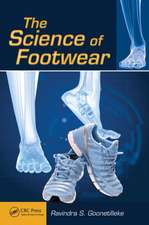Industrial Chemical Exposure: Guidelines for Biological Monitoring, Third Edition
Autor Robert R. Lauwerys, Perrine Hoeten Limba Engleză Hardback – 26 apr 2001
SEE WHAT'S NEW IN THE THIRD EDITION:
This authoritative book summarizes what is known about biological monitoring for inorganic, organic and organometallic substances. It provides a summary table with practical recommendations, giving you quick and easy access to the data. With INDUSTRIAL CHEMICAL EXPOSURE: GUIDELINES FOR BIOLOGICAL MONITORING you will understand the objectives of biological monitoring, the types of biological monitoring methods, their advantages and limitations, as well as practical aspects that must be considered before initiating a biological monitoring program.
Preț: 1822.47 lei
Preț vechi: 2222.52 lei
-18% Nou
Puncte Express: 2734
Preț estimativ în valută:
348.71€ • 364.13$ • 287.97£
348.71€ • 364.13$ • 287.97£
Carte tipărită la comandă
Livrare economică 15-29 aprilie
Preluare comenzi: 021 569.72.76
Specificații
ISBN-13: 9781566705455
ISBN-10: 1566705452
Pagini: 664
Ilustrații: 29 black & white illustrations, 73 black & white tables
Dimensiuni: 156 x 234 x 40 mm
Greutate: 1.39 kg
Ediția:Revizuită
Editura: CRC Press
Colecția CRC Press
ISBN-10: 1566705452
Pagini: 664
Ilustrații: 29 black & white illustrations, 73 black & white tables
Dimensiuni: 156 x 234 x 40 mm
Greutate: 1.39 kg
Ediția:Revizuită
Editura: CRC Press
Colecția CRC Press
Public țintă
ProfessionalCuprins
INTRODUCTION. Definitions and Objectives of Biological Monitoring of Exposure to Industrial Chemicals. Classification of Biological Monitoring Methods. Principal Advantages of Biological Monitoring. Conditions and Limitations of Biological Monitoring. Biological Monitoring of Susceptibility. Selection of the Appropriate Biological Media and Sampling Time. Interpretation of Results. BIOLOGICAL MONITORING OF EXPOSURE TO INORGANIC AND ORGANOMETALLIC SUBSTANCES. Aluminum. Antimony. Arsenic. Barium. Beryllium. Bromine. Cadmium. Carbon Disulfide. Chromium. Cobalt. Copper. Fluoride. Germanium. Hydrogen Sulfide. Lead. Manganese. Mercury. Molybdenum. Nickel. Nitrous Oxide. Perchlorate. Platinum. Selenium. Silver. Tellurium. Thallium. Uranium. Vanadium. Zinc. BIOLOGICAL MONITORING OF EXPOSURE TO ORGANIC SUBSTANCES. Unsubstituted Aliphatic and Alicyclic Hydrocarbons. Unsubstituted Aromatic Hydrocarbons. Halogenated Hydrocarbons. Amino and Nitro Derivatives. Alcohols. Glycols and Derivatives. Ketones. Aldehydes. Amides and Anhydrides. Phenol and Derivatives. Carbon Monoxide. Cyanides and Nitriles. Isocyanates. Pesticides. Ethers. Miscellaneous Chemicals. Mutagenic and Carcinogenic Substances. SUMMARY OF RECOMMENDATIONS.
Notă biografică
Robert R. Lauwerys, Perrine Hoet
Descriere
A practical guide to biological monitoring for industrial chemical exposure assessment, this authoritative book summarizes what is known about biological monitoring for inorganic, organic, and organometallic substances. The authors explore the objectives of biological monitoring, the types of biological monitoring methods, their advantages and limitations, as well as practical aspects that must be considered before initiating a biological monitoring program. They identify the potential biological markers for assessing exposure or body burden and include summary tables with practical recommendations that give readers quick and easy access to the data.


















